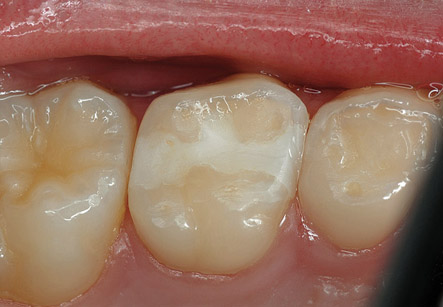Resin Modified Glass Ionomer Cement Filling
What is it?
A Glass Ionomer Cement (GIC) is a dental restorative material used in dentistry for filling teeth and luting cements. These materials are based on the reaction of silicate glass powder and polyalkenoic acid. These are a material made from acrylic and a component of glass – flouroaluminosilicate. They can be bonded to patient’s tooth using a chemical reaction which makes the bond very strong. The filling is bonded straight onto the tooth, and no real preparation is required before you are fitted with one. Some dentists maintain that glass ionomer fillings are not very strong and last only 5 years or so.
Introduction
These tooth-coloured materials were introduced in 1972 for use as restorative materials for anterior teeth (particularly for eroded areas, Class III and V cavities).
General properties
• Results from clinical studies, do not support the use of conventional or metal-reinforced glass ionomer restorations in primary molars, due to higher occlusal stress loads.
• As GICs bond chemically to dental hard tissues and release fluoride for a relatively long period, modern day applications of GICs have expanded.
Iran offers a superior Dental treatments that is world best quality. For patients from the USA, and Europe for example, the savings can be 60% or more

• The advantageous properties of glass ionomer cements make them useful materials in the restoration of carious lesions in low-stress areas such as smooth-surface and small anterior proximal cavities in primary teeth.
• Though use of glass ionomers in molar teeth is common as cementing, luting or basing materials, temporary to intermediate term restorations in children and adults particularly in difficult and dentally compromised cases, and for medically compromised and elderly patients.
• GIC functions as a base or cement for other forms of fillings if the cavity is particularly big or the cavity reaches below the gum line.
• It can be used in babies and small children, no drilling or preparation is needed and so the pain is minimal
• It can be used for front teeth and areas that aren’t used to bite or chew, i.e. around the necks of the teeth.
• In comparison to many filling materials, glass ionomer is quick and fairly simple to use, enabling cairies to be treated well with little use of valuable surgery time.
GICs are commonly classified into five principal types:
• Metal-reinforced Glass Ionomer Cements
• Conventional Glass Ionomer Cements
• Hybrid Ionomer Cements (Also known as Dual-cured Glass Ionomer Cements)
• Tri-cure Glass Ionomer Cements
• Resin Modified Glass Ionomer Cements (Conventional with addition of HEMA)
Resin Modified Glass Ionomer Cements:
Resin Modified Glass Ionomer Cements are conventional glass ionomer cements with addition of HEMA and photo-initiators.
Advantages:
• High retention rate
• Inherent adhesion to tooth structure
• Little shrinkage and good marginal seal
• Biocompatible
• Fluoride release and hence caries inhibition
• Minimal cavity preparation required hence easy to use on children in and suitable for use even in absence of skilled dental manpower and facilities (such as in ART)
Disadvantages:
• Abrasive
• Brittle
• Some products release less fluoride than conventional GIC
• Soluble
• Less aesthetic than composite
• Water sensitive during setting phase.
• Not inherently radiopaque though addition of radiodense additives such as barium can alter radiodensity